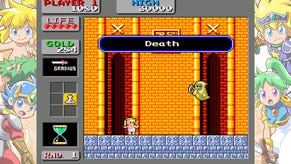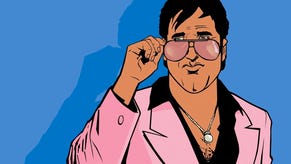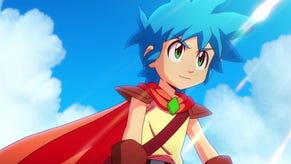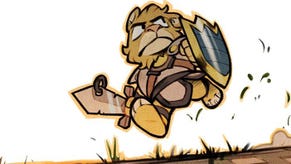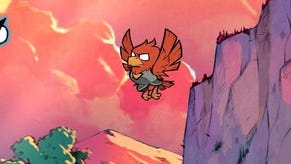Wonder Boy: The Dragon's Trap review
High above the mucky-muck.
Somewhere in an alternate universe, Wonder Boy 3: The Dragon's Trap is mentioned in the same breath as Mega Man 2 and The Legend of Zelda as one of the great classics of the 8-bit console era. In our reality, however, it settles for more of a cult status. Originally released in 1989 for the Sega Master System by Japanese developer Westone, The Dragon's Trap was the second entry in the action-adventure series Monster World, itself a spin-off of the action game Wonder Boy, first released in arcades in 1986.
The Wonder Boy series can be hard to make sense of: Ryuichi Nishizawa holds onto the copyright for the character designs, while Sega owns the name, and a large number of ports and spin-offs have been released in different markets for various consoles. When The Dragon's Trap was ported by Hudson Soft for the Turbografx 16 (aka PC Engine) it became known as Dragon's Curse in the US and Adventure Island in Japan - not to be confused with Adventure Island on the NES, which was Hudson's port of the original Wonder Boy. But localisation muddles notwithstanding, The Dragon's Trap is generally considered to be one of the best games released for the Master System, and arguably the best game in the franchise. A love letter from childhood fans, French developer Lizardcube's remake (which ditches the "3") is about as impressive and lavish a refurbishment as one could find.
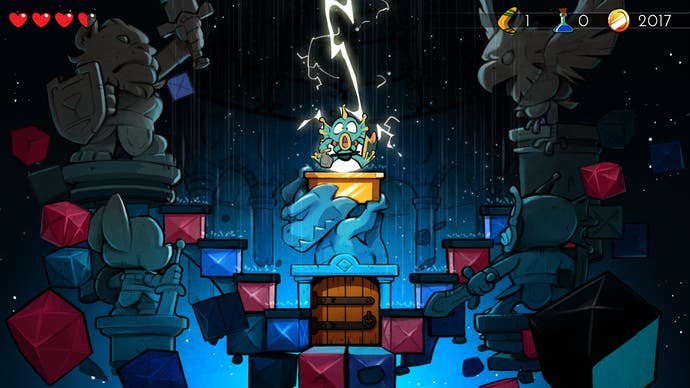
As with most games of its era, the plot is threadbare: Wonder Boy (or Girl, in one of Lizardcube's more significant additions) is cursed at the start of the game with a lizard form, and must progress through a series of levels and defeat a number of dragon bosses in order to become human again. After defeating a dragon, the player gains access to an additional animal form, which can be used to access new areas from the game's central hub.
There's also a light RPG element, as players can buy weapons, shields and armour upgrades from a shopkeeper - Monster World's iconically laconic smoking pig - using gold obtained from enemies and treasure chests. There are also hidden vendors and secret rooms to be discovered, many of which contain rare items, while magic and supplementary weapons such as fireballs, boomerangs and lightning bolts can also be purchased (pro tip: the boomerang is everything). The player will also periodically come across a nurse who can restore the player's hearts for a fee, which increases throughout the course of the game.
The fundamentals are essentially unchanged from the 1989 original, so enjoyment of the game's systems will depend to a degree on a tolerance for the relative simplicity and hair-pulling design quirks characteristic of the era. Thankfully, The Dragon's Trap has a lot of charm and is still fun to play today. The central concept of opening up new areas by transforming into different animal forms is reminiscent of item acquisition in The Legend of Zelda.

Lizard-Man, the first form Wonder Boy or Wonder Girl transforms into, has a fire breathing attack with longer range than a sword, can duck and is immune to lava. Mouse-Man can stick to chequered walls and ceilings and fit through small gaps. Piranha-Man can swim (other characters just walk across the floor), while Lion-Man can swing his sword in a 180 degree vertical arc, and Hawk-Man can fly but is vulnerable to water. Combat relies heavily on timing and positioning, and looking for openings to attack or avoid enemies is lent a pleasing cadence thanks to the game's tight controls.
The use of a central hub from which players can traverse left or right in an open-ended fashion builds on Metroid, and backtracking with different characters can lead to the discovery of secret areas. When you die in the game (and you'll die quite a lot), you return to the game's hub town with all gold and items intact, which is useful for struggling players who can return to the fray with a better chance after buying superior gear.
The Dragon's Trap is a tricky game, however, with a noticeable spike in difficulty in its second half. Sometimes, this difficulty stems not so much from the mechanics but from working out the best character to clear an area. It took me over nine hours to complete the game, which was longer than I expected, and at least two of those were spent grinding a difficult late-game area with a character I eventually realised wasn't really designed for it.
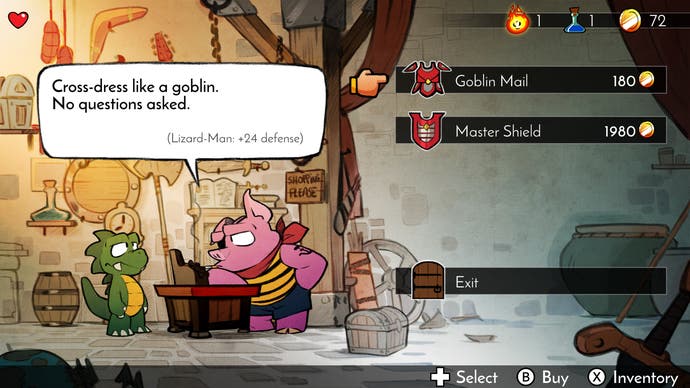
Discovering the optimal way forward is part of The Dragon's Trap's core appeal, of course, but Lizardcube has made some concessions to modernity: the hub town's 'password pig' will drop hints to aid progression, item menus are clearer, and the graphical upgrade sometimes makes secrets a little easier to spot. The game is fair in its challenges, on the whole - don't expect Ghosts 'n' Goblins or Battletoads levels of masochism here. For gamers who aren't fond of old-school difficulty or want to relax a bit more, Lizardcube has implemented an easy mode. On the flipside, there's a hard mode that adds a heart-sapping time limit, partially inspired by the original's predecessor Wonder Boy in Monster Land.
Given Lizardcube's reverent devotion to the original's gameplay, the standout element of The Dragon's Trap lies with its audiovisual overhaul. It can be played in a widescreen, 60fps rendition of the original's 1989 graphics or, at the press of a button, a beautiful cartoon veneer hand-drawn by animator Ben Fiquet, wiping between the two styles effortlessly without interrupting play.
We've seen similar graphical switches before - remasters of Lucasarts games such as Day of the Tentacle and the upcoming Full Throttle incorporate this technique - but no other game pulls it off quite as dramatically as The Dragon's Trap. That its gorgeous bandes dessinées art style looks so fluid yet still syncs perfectly with the frames of the 8-bit original is perhaps Lizardcube's greatest triumph.
Enemies in particular emanate a rare charm, from head-detaching skeletons and shuffling Cyclopes to front-flipping ninjas and every trope between. The closest graphical equivalent is perhaps Good-Feel's fantastic Wario Land: The Shake Dimension on the Wii, or to a lesser extent, Hollow Knight. In terms of extra visual options, there's no 4:3 mode, but when playing with retro graphics scanlines can be imposed and varied in intensity from 0-100 per cent, in order to nostalgise to taste.
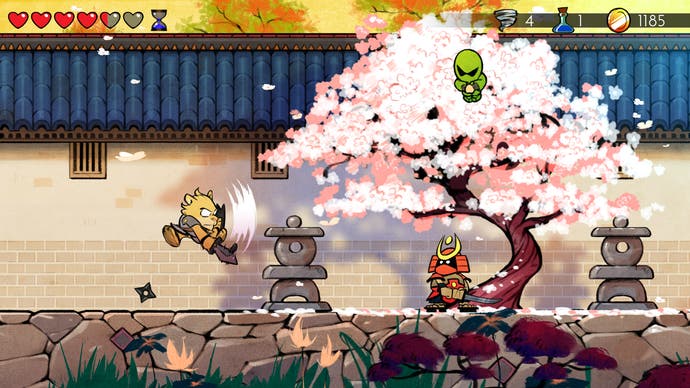
The soundtrack has been updated and expanded with similar care. Shinichi Sakamoto's original score incorporated catchy melodies typical of the constraints of the time, and these are now updated with real instruments courtesy of composers Michael Geyre and Romain Gauthier. The game's main theme, somewhat repetitive in the original release, now varies by area: an early beach level is punctuated by Caribbean rhythms, for instance, while the central town features a relaxing mandolin riff. Like the visuals, there is a dedicated button (R3 on PS4) for switching between 8-bit and modern day sounds. By pausing the game and fiddling with the settings you can pair the updated music with the old sound effects, or the new sound effects with the old music. In perhaps the game's nerdiest touch, there's even an option to replicate the Master System's distinctive FM Sound Unit.
Such attention to detail is hugely impressive. Lead designer Omar Cornut (Pixeljunk Shooter, Tearaway) has previously worked on Master System emulation and incorporated these techniques in The Dragon's Trap. The remake includes an autosave between levels, but, in a nostalgic touch, still maintains the password system of the Master System version: if you have an old password scrawled in the notes of your original Dragon's Trap instruction manual from near enough 30 years ago it will actually work in the remake, and vice versa.
In terms of updating an old classic, Lizardcube has pretty much set the bar, especially given the small size of the team working on it. With any luck, it might even help shine a belated limelight on the series as a whole. By sheer coincidence, there's a spiritual successor in the works from Game Atelier named Monster Boy and the Cursed Kingdom, which, like The Dragon's Trap remake, has Nishizawa's blessing, and whose developers (also French) are friendly with Lizardcube.
Wonder Boy: The Dragon's Trap is a must-own for fans of the series and old-school gamers in general. For those without nostalgia for 8-bit titles, the game's relative simplicity may not measure up to the polish of modern platforming adventures such as Shovel Knight, Momodora or Shantae (which shares some of Wonder Boy's DNA), but it's a labour of love that sets an example for all retro remasters.




